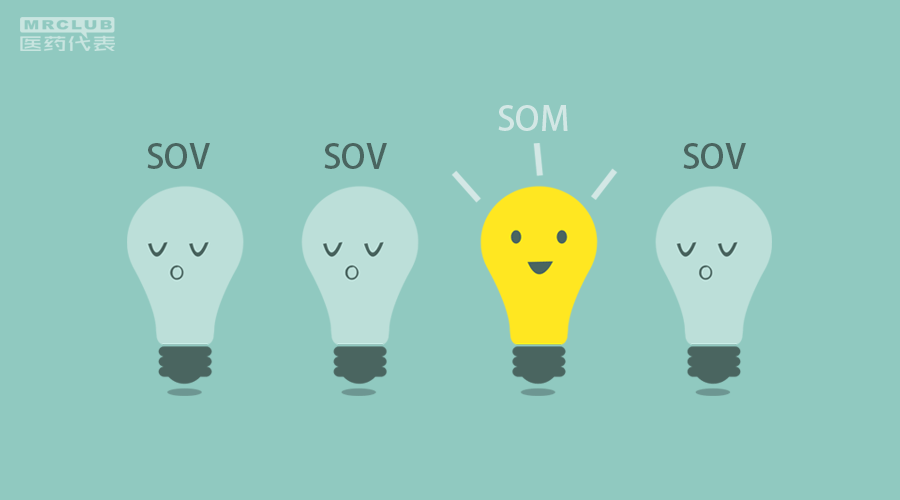
Those who frequently visit hospitals and participate in medical activities may sometimes overhear experts chatting: “This company is not doing well; there’s hardly a peep from them.”
What does this “sound” mean? Generally, it refers to two things: first, the market sound, which mainly indicates that the marketing department’s academic activities are few, and the channels for the company’s product information to reach the doctor community are severely lacking.
The second sound is the sales sound, often observed in new markets or markets that have been vacant for a long time, or even if there are no vacancies, representatives are rarely seen visiting.
Today, I will discuss the sales sound.
▌ SOV: The Key Indicator of Representative Competition
The sales sound is often measured by a metric called SOV in some foreign companies.
The term SOV, originally introduced by the advertising industry, stands for Share of Voice, which is generally used in the advertising sector to indicate brand advertising exposure.
When introduced to the pharmaceutical industry, SOV became a measure of the share of visits that a pharmaceutical representative makes to doctors in their daily activities centered around prescription requirements. Specifically, it refers to the number and duration of visits to doctors, and broadly includes detailing time by representatives. If data is available, SOV = Effective Visit Time of Representatives / Total Effective Visit Time of All Similar Product Representatives.
For example, some research companies may ask doctors to fill out questionnaires about how many times a certain product visits them in a month and how long each visit lasts; this is essentially conducting an SOV survey.
Why do pharmaceutical companies pay so much attention to SOV? There’s a consensus among industry managers: without attendance rates, there are no visit rates; without visit rates, there are no prescription rates.
Pharmaceutical companies understand that the key to increasing sales lies in high-quality pharmaceutical representatives. These high-quality representatives’ effective visit activities enable the effective transmission of their product information, leading to widespread application of the products. However, high-quality visits are difficult to quantify, so SOV is used as a measure. An increase in SOV leads to an increase in the information received by clients about the company’s products, which in turn increases client approval and ultimately boosts sales. This has been the mindset of companies in the past.
Thus, we see that every company requires representatives to visit a certain number of clients daily, and even demands joint visits, targeting, and call recordings. All these measures aim to ensure an increase in SOV.
Moreover, since changes in SOV precede changes in sales, it can also serve as a predictive indicator for market share (MS).
▌ What is SOM?
Discussing SOM today does not mean that SOV is no longer important; SOV has been valued by pharmaceutical companies in the past and will continue to be for some time.
That said, I still want to share the concept of SOM with everyone.
First, it’s important to clarify that our SOM is not the Share of Market or Market Share in the advertising industry, but rather Share of Mind, which can be understood as the weight of your product in the minds of customers.
As the maturity of the pharmaceutical market increases, along with fierce sales competition and the gradual improvement of pharmaceutical representatives’ professional skills, pharmaceutical company managers have realized that solely relying on SOV cannot enable the company or team to win in competition. Therefore, the requirements for representatives’ visits have become more refined. In this regard, some pharmaceutical team managers, both domestic and international, are continuing to explore what factors in the daily behaviors of excellent pharmaceutical representatives bring them higher productivity, in addition to SOV.
The concept of SOM was first proposed by Japanese pharmaceutical company managers. Compared to SOV, which focuses on prescription requirements, SOM centers on obtaining the “share of mind” of target doctors, aiming to establish long-term relationships with them.
According to relevant surveys, Japanese doctors are about 1.5 times busier than their counterparts in Europe and the U.S. A standard for evaluating whether a representative is excellent is their ability to answer questions effectively.
Since doctors are busy with consultations, research projects, and learning, representatives who can answer questions promptly receive high evaluations. Moreover, some doctors believe that if they ask a representative about products from other companies or other products in the same field and the representative cannot answer, that representative’s role becomes meaningless.
In recent years, we can also observe some changes in domestic markets, such as some companies revising their training courses to focus on a patient-centered system, while others are dividing general and specialty drugs into two structures. In reality, these changes implicitly consider both SOV and SOM factors, as the domestic and international healthcare market environments have greatly changed.
As an ordinary pharmaceutical representative, if you want to excel, you should actively adapt to these industry changes and consider SOM more during visits, which may lead to better performance.

MRCLUB is Recruiting Original Authors
With hundreds of thousands of precise members reading daily, it helps you quickly enhance your personal brand and expand your influence in the pharmaceutical industry and social media! (For details, please visit the website http://wemr.club)

Pharmaceutical Representatives: Growing With You!